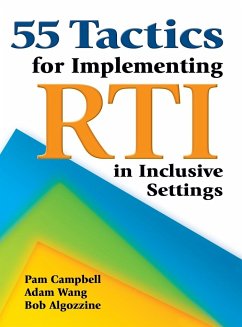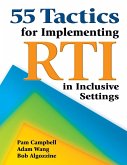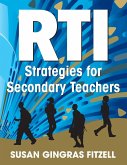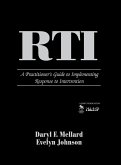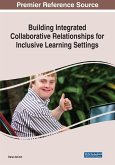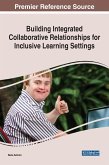- Gebundenes Buch
- Merkliste
- Auf die Merkliste
- Bewerten Bewerten
- Teilen
- Produkt teilen
- Produkterinnerung
- Produkterinnerung
Boost academic achievement for all students in your inclusive classroom! As schools implement RTI in general education settings, educators need easy access to information about effective teaching and intervention tactics for diverse learners. This resource offers teachers 55 research-based instructional tactics organized around four components-planning, managing, delivering, and evaluating. Teachers will also find: Accommodations/modifications for adapting tactics to meet individual learning needs Illustrations showing how to implement tactics within each tier of a three-tier RTI framework…mehr
Andere Kunden interessierten sich auch für
![55 Tactics for Implementing RTI in Inclusive Settings 55 Tactics for Implementing RTI in Inclusive Settings]() Pam Campbell55 Tactics for Implementing RTI in Inclusive Settings44,99 €
Pam Campbell55 Tactics for Implementing RTI in Inclusive Settings44,99 €![RTI Strategies for Secondary Teachers RTI Strategies for Secondary Teachers]() Susan Gingras FitzellRTI Strategies for Secondary Teachers35,99 €
Susan Gingras FitzellRTI Strategies for Secondary Teachers35,99 €![RTI RTI]() Daryl F. MellardRTI89,99 €
Daryl F. MellardRTI89,99 €![Building Integrated Collaborative Relationships for Inclusive Learning Settings Building Integrated Collaborative Relationships for Inclusive Learning Settings]() Building Integrated Collaborative Relationships for Inclusive Learning Settings178,99 €
Building Integrated Collaborative Relationships for Inclusive Learning Settings178,99 €![Building Integrated Collaborative Relationships for Inclusive Learning Settings Building Integrated Collaborative Relationships for Inclusive Learning Settings]() Building Integrated Collaborative Relationships for Inclusive Learning Settings229,99 €
Building Integrated Collaborative Relationships for Inclusive Learning Settings229,99 €![Implementing Response to Intervention Implementing Response to Intervention]() Susan L. HallImplementing Response to Intervention80,99 €
Susan L. HallImplementing Response to Intervention80,99 €![Math Instruction for Students with Learning Difficulties Math Instruction for Students with Learning Difficulties]() Susan Perry GurganusMath Instruction for Students with Learning Difficulties202,99 €
Susan Perry GurganusMath Instruction for Students with Learning Difficulties202,99 €-
-
-
Boost academic achievement for all students in your inclusive classroom! As schools implement RTI in general education settings, educators need easy access to information about effective teaching and intervention tactics for diverse learners. This resource offers teachers 55 research-based instructional tactics organized around four components-planning, managing, delivering, and evaluating. Teachers will also find: Accommodations/modifications for adapting tactics to meet individual learning needs Illustrations showing how to implement tactics within each tier of a three-tier RTI framework Strategies for meeting the needs of diverse students, classrooms, and schools A wealth of reproducibles, worksheets, and forms for immediate use
Hinweis: Dieser Artikel kann nur an eine deutsche Lieferadresse ausgeliefert werden.
Hinweis: Dieser Artikel kann nur an eine deutsche Lieferadresse ausgeliefert werden.
Produktdetails
- Produktdetails
- Verlag: Corwin
- Seitenzahl: 218
- Erscheinungstermin: 10. November 2009
- Englisch
- Abmessung: 286mm x 221mm x 16mm
- Gewicht: 821g
- ISBN-13: 9781412942393
- ISBN-10: 141294239X
- Artikelnr.: 26260306
- Herstellerkennzeichnung
- Libri GmbH
- Europaallee 1
- 36244 Bad Hersfeld
- gpsr@libri.de
- Verlag: Corwin
- Seitenzahl: 218
- Erscheinungstermin: 10. November 2009
- Englisch
- Abmessung: 286mm x 221mm x 16mm
- Gewicht: 821g
- ISBN-13: 9781412942393
- ISBN-10: 141294239X
- Artikelnr.: 26260306
- Herstellerkennzeichnung
- Libri GmbH
- Europaallee 1
- 36244 Bad Hersfeld
- gpsr@libri.de
Pam Campbell is an associate professor in the Department of Special Education at the University of Nevada, Las Vegas. During her 35 years as an educator, she has taught university courses in instruction, assessment, curriculum, and classroom management for both general and special educators. In addition, she has been a public school teacher in general education, Chapter I, and special education classrooms. She served in the dual role of university professor and coordinator of seven professional development schools (PDS) at the University of Connecticut and currently serves at UNLV as coordinator of the Paradise PDS. Her research interests focus on linking the preparation of teacher candidates and sustained professional development of practicing teachers through technology. Her work has been published in TEACHING Exceptional Children, Remedial and Special Education, Record in Educational Leadership, the Professional Educator, and the Council for Administrators of Special Education. She is also the coauthor of Improving Social Competence: Techniques for Elementary Teachers. She has served the field of special education through numerous local, state, regional, and national presentations and as field reviewer for Exceptional Children, the Journal of Special Education Technology, TEACHING Exceptional Children, and Teacher Education and Special Education . She earned her PhD at the University of Florida.
Preface
Acknowledgments
About the Authors
Part I. Planning Instruction
1. Decide What to Teach
Assess to Identify Gaps in Performance
Establish Logical Sequences of Instruction
Consider Contextual Variables
2. Decide How to Teach
Set Instructional Goals/Establish Performance Standards
Choose Instructional Methods and Materials
Establish Grouping Structures
Pace Instruction Appropriately
Monitor Performance and Replan Instruction
3. Communicate Realistic Expectations
Teach Goals, Objectives, and Standards
Teach Students to Be Active, Involved Learners
Teach Students Consequences of Performance
Part II. Managing Instruction
4. Prepare for Instruction
Set Classroom Rules/Communicate and Teach Classroom Rules
Communicate Consequences of Behavior
Handle Disruptions Efficiently
Teach Students to Manage Their Own Behavior
5. Use Time Productively
Establish Routines and Procedures
Organize Physical Space
Allocate Sufficient Time to Academic Activities
6. Establish Positive Environments
Make the Classroom a Pleasant, Friendly Place
Accept Individual Differences
Establish Supportive, Cooperative Learning Environments
Create a Nonthreatening Learning Environment
Part III. Delivering Instruction
7. Present Information
Gain and Maintain Attention
Review Prior Skills or Lessons
Provide Organized, Relevant Lessons
Show Enthusiasm and Interest
Use Rewards Effectively
Consider Level and Student Interest
Model Thinking Skills
Teach Fact-Finding Skills
Teach Divergent Thinking
Teach Learning Strategies
Develop Automaticity
Vary Opportunities for Practice/Vary Methods of Practice
Monitor Amount of Work Assigned
8. Monitor Presentations
Give Immediate, Frequent, Explicit Feedback/Provide Specific Praise and
Encouragement
Model Correct Performance
Provide Prompts and Cues
Check Student Understanding
Monitor Performance Regularly/Monitor Performance During Practice
Use Peers to Improve Instruction
Provide Opportunities for Success/Limit Opportunities for Failure
Monitor Engagement Rates
9. Adjust Presentations
Adapt Lessons to Meet Student Needs
Provide Varied Instructional Options
Alter Pace
Part IV. Evaluating Instruction
10. Monitor Student Understanding
Check Understanding of Directions
Check Procedural Understanding
Monitor Student Success Rate
11. Monitor Engaged Time
Check Student Participation/Teach Students to Monitor Their Own
Participation
12. Keep Records of Student Progress
Teach Students to Chart Their Own Progress
Regularly Inform Students of Performance
Maintain Records of Student Performance
13. Use Data to Make Decisions
Use Student Progress to Make Teaching Decisions
Use Data to Decide If More Services Are Warranted/Use Student Progress to
Decide When to Discontinue Services
Appendix A: RTI Accommodations/Modifications Checklist
Appendix B: RTI Accommodations/Modifications Worksheet
Appendix C: Documentation of RTI Accomodations/Modifications
References
Additional Readings
Selected Internet Resources: RTI Accomodations/Modifications
Index
Acknowledgments
About the Authors
Part I. Planning Instruction
1. Decide What to Teach
Assess to Identify Gaps in Performance
Establish Logical Sequences of Instruction
Consider Contextual Variables
2. Decide How to Teach
Set Instructional Goals/Establish Performance Standards
Choose Instructional Methods and Materials
Establish Grouping Structures
Pace Instruction Appropriately
Monitor Performance and Replan Instruction
3. Communicate Realistic Expectations
Teach Goals, Objectives, and Standards
Teach Students to Be Active, Involved Learners
Teach Students Consequences of Performance
Part II. Managing Instruction
4. Prepare for Instruction
Set Classroom Rules/Communicate and Teach Classroom Rules
Communicate Consequences of Behavior
Handle Disruptions Efficiently
Teach Students to Manage Their Own Behavior
5. Use Time Productively
Establish Routines and Procedures
Organize Physical Space
Allocate Sufficient Time to Academic Activities
6. Establish Positive Environments
Make the Classroom a Pleasant, Friendly Place
Accept Individual Differences
Establish Supportive, Cooperative Learning Environments
Create a Nonthreatening Learning Environment
Part III. Delivering Instruction
7. Present Information
Gain and Maintain Attention
Review Prior Skills or Lessons
Provide Organized, Relevant Lessons
Show Enthusiasm and Interest
Use Rewards Effectively
Consider Level and Student Interest
Model Thinking Skills
Teach Fact-Finding Skills
Teach Divergent Thinking
Teach Learning Strategies
Develop Automaticity
Vary Opportunities for Practice/Vary Methods of Practice
Monitor Amount of Work Assigned
8. Monitor Presentations
Give Immediate, Frequent, Explicit Feedback/Provide Specific Praise and
Encouragement
Model Correct Performance
Provide Prompts and Cues
Check Student Understanding
Monitor Performance Regularly/Monitor Performance During Practice
Use Peers to Improve Instruction
Provide Opportunities for Success/Limit Opportunities for Failure
Monitor Engagement Rates
9. Adjust Presentations
Adapt Lessons to Meet Student Needs
Provide Varied Instructional Options
Alter Pace
Part IV. Evaluating Instruction
10. Monitor Student Understanding
Check Understanding of Directions
Check Procedural Understanding
Monitor Student Success Rate
11. Monitor Engaged Time
Check Student Participation/Teach Students to Monitor Their Own
Participation
12. Keep Records of Student Progress
Teach Students to Chart Their Own Progress
Regularly Inform Students of Performance
Maintain Records of Student Performance
13. Use Data to Make Decisions
Use Student Progress to Make Teaching Decisions
Use Data to Decide If More Services Are Warranted/Use Student Progress to
Decide When to Discontinue Services
Appendix A: RTI Accommodations/Modifications Checklist
Appendix B: RTI Accommodations/Modifications Worksheet
Appendix C: Documentation of RTI Accomodations/Modifications
References
Additional Readings
Selected Internet Resources: RTI Accomodations/Modifications
Index
Preface
Acknowledgments
About the Authors
Part I. Planning Instruction
1. Decide What to Teach
Assess to Identify Gaps in Performance
Establish Logical Sequences of Instruction
Consider Contextual Variables
2. Decide How to Teach
Set Instructional Goals/Establish Performance Standards
Choose Instructional Methods and Materials
Establish Grouping Structures
Pace Instruction Appropriately
Monitor Performance and Replan Instruction
3. Communicate Realistic Expectations
Teach Goals, Objectives, and Standards
Teach Students to Be Active, Involved Learners
Teach Students Consequences of Performance
Part II. Managing Instruction
4. Prepare for Instruction
Set Classroom Rules/Communicate and Teach Classroom Rules
Communicate Consequences of Behavior
Handle Disruptions Efficiently
Teach Students to Manage Their Own Behavior
5. Use Time Productively
Establish Routines and Procedures
Organize Physical Space
Allocate Sufficient Time to Academic Activities
6. Establish Positive Environments
Make the Classroom a Pleasant, Friendly Place
Accept Individual Differences
Establish Supportive, Cooperative Learning Environments
Create a Nonthreatening Learning Environment
Part III. Delivering Instruction
7. Present Information
Gain and Maintain Attention
Review Prior Skills or Lessons
Provide Organized, Relevant Lessons
Show Enthusiasm and Interest
Use Rewards Effectively
Consider Level and Student Interest
Model Thinking Skills
Teach Fact-Finding Skills
Teach Divergent Thinking
Teach Learning Strategies
Develop Automaticity
Vary Opportunities for Practice/Vary Methods of Practice
Monitor Amount of Work Assigned
8. Monitor Presentations
Give Immediate, Frequent, Explicit Feedback/Provide Specific Praise and
Encouragement
Model Correct Performance
Provide Prompts and Cues
Check Student Understanding
Monitor Performance Regularly/Monitor Performance During Practice
Use Peers to Improve Instruction
Provide Opportunities for Success/Limit Opportunities for Failure
Monitor Engagement Rates
9. Adjust Presentations
Adapt Lessons to Meet Student Needs
Provide Varied Instructional Options
Alter Pace
Part IV. Evaluating Instruction
10. Monitor Student Understanding
Check Understanding of Directions
Check Procedural Understanding
Monitor Student Success Rate
11. Monitor Engaged Time
Check Student Participation/Teach Students to Monitor Their Own
Participation
12. Keep Records of Student Progress
Teach Students to Chart Their Own Progress
Regularly Inform Students of Performance
Maintain Records of Student Performance
13. Use Data to Make Decisions
Use Student Progress to Make Teaching Decisions
Use Data to Decide If More Services Are Warranted/Use Student Progress to
Decide When to Discontinue Services
Appendix A: RTI Accommodations/Modifications Checklist
Appendix B: RTI Accommodations/Modifications Worksheet
Appendix C: Documentation of RTI Accomodations/Modifications
References
Additional Readings
Selected Internet Resources: RTI Accomodations/Modifications
Index
Acknowledgments
About the Authors
Part I. Planning Instruction
1. Decide What to Teach
Assess to Identify Gaps in Performance
Establish Logical Sequences of Instruction
Consider Contextual Variables
2. Decide How to Teach
Set Instructional Goals/Establish Performance Standards
Choose Instructional Methods and Materials
Establish Grouping Structures
Pace Instruction Appropriately
Monitor Performance and Replan Instruction
3. Communicate Realistic Expectations
Teach Goals, Objectives, and Standards
Teach Students to Be Active, Involved Learners
Teach Students Consequences of Performance
Part II. Managing Instruction
4. Prepare for Instruction
Set Classroom Rules/Communicate and Teach Classroom Rules
Communicate Consequences of Behavior
Handle Disruptions Efficiently
Teach Students to Manage Their Own Behavior
5. Use Time Productively
Establish Routines and Procedures
Organize Physical Space
Allocate Sufficient Time to Academic Activities
6. Establish Positive Environments
Make the Classroom a Pleasant, Friendly Place
Accept Individual Differences
Establish Supportive, Cooperative Learning Environments
Create a Nonthreatening Learning Environment
Part III. Delivering Instruction
7. Present Information
Gain and Maintain Attention
Review Prior Skills or Lessons
Provide Organized, Relevant Lessons
Show Enthusiasm and Interest
Use Rewards Effectively
Consider Level and Student Interest
Model Thinking Skills
Teach Fact-Finding Skills
Teach Divergent Thinking
Teach Learning Strategies
Develop Automaticity
Vary Opportunities for Practice/Vary Methods of Practice
Monitor Amount of Work Assigned
8. Monitor Presentations
Give Immediate, Frequent, Explicit Feedback/Provide Specific Praise and
Encouragement
Model Correct Performance
Provide Prompts and Cues
Check Student Understanding
Monitor Performance Regularly/Monitor Performance During Practice
Use Peers to Improve Instruction
Provide Opportunities for Success/Limit Opportunities for Failure
Monitor Engagement Rates
9. Adjust Presentations
Adapt Lessons to Meet Student Needs
Provide Varied Instructional Options
Alter Pace
Part IV. Evaluating Instruction
10. Monitor Student Understanding
Check Understanding of Directions
Check Procedural Understanding
Monitor Student Success Rate
11. Monitor Engaged Time
Check Student Participation/Teach Students to Monitor Their Own
Participation
12. Keep Records of Student Progress
Teach Students to Chart Their Own Progress
Regularly Inform Students of Performance
Maintain Records of Student Performance
13. Use Data to Make Decisions
Use Student Progress to Make Teaching Decisions
Use Data to Decide If More Services Are Warranted/Use Student Progress to
Decide When to Discontinue Services
Appendix A: RTI Accommodations/Modifications Checklist
Appendix B: RTI Accommodations/Modifications Worksheet
Appendix C: Documentation of RTI Accomodations/Modifications
References
Additional Readings
Selected Internet Resources: RTI Accomodations/Modifications
Index

